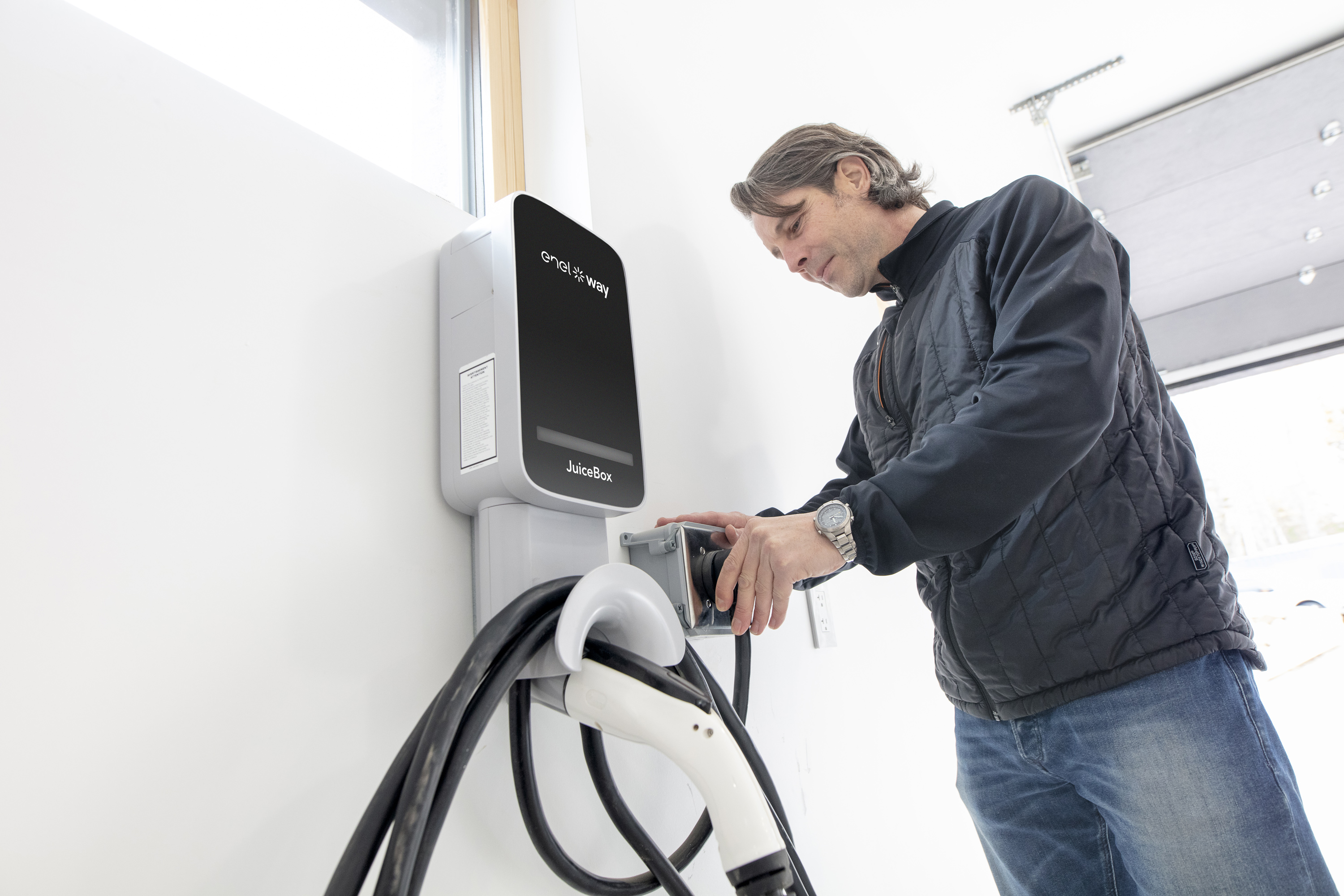Hardwired versus plug-in charging stations

With all the EV models coming on the market these days, choosing among them is challenging enough. But for those who plan to charge at home, you’ve got another decision to make—hardwired or plug-in charging station? Your choice of EV supply equipment (EVSE) and charger accessories will depend on your EV’s charging capabilities and your situation, from your budget to your need for portability.
More than 80% of EV owners charge at home, according to the U.S. Department of Energy. A recent JD Power survey showed that most EV owners prefer Level 2 (240-volt) permanent charging installations compared to Level 2 portable chargers and Level 1 (120-volt) cords.
Let’s take a closer look at Level 2 hardwired versus plug-in charging stations and the differences that could impact your decision and satisfaction.
Hardwired charging stations
Level 2 charging stations are high-power, continuous-use devices, like HVAC equipment. If you choose the hardwired option, it’s mounted on the wall and includes three feet of flexible conduit and service wires that extend from it. These wires meet and connect to wires coming from your electrical panel in a junction box.
Hardwired units offer a larger range of amperage and charge-speed options than plug-in units do. And because hardwiring provides a watertight connection capable of handling rain, snow, sleet, and ice, it’s a solid option for outdoor use. However, hardwired units aren’t intended to be portable, so you’ll need an electrician to help if you decide to move.
Hardwired charging stations can be more expensive overall due to the cost of the charger itself, larger cables, and more labor-intensive installation. But they provide a solid connection and more options for charging strength.
Plug-in charging stations
Plug-in charging stations let you do just that—insert the plug from your EVSE directly into a 240-volt outlet. These units typically include a short, 240-volt input cord. Most outlets aren’t rated to let you plug and unplug regularly, so plan on leaving the charging station connected at all times.
If your home already has a 240-volt outlet—perhaps for a clothes dryer or range—you can get a plug that works with it. Note, however, that some 240-volt outlets may allow only limited charging speeds, depending on the outlet’s maximum amperage. (More on that below.) With a 240-volt outlet, however, you can just mount the charging station and start using it. If you don’t have a 240-volt outlet, an electrician can install one that matches the plug type you select and confirm that the setup complies with local codes. Receptacles can’t support the weight of EV supply equipment (EVSE), however, so be sure to mount the charging station on the wall or a stand near the receptacle.
JuiceBox: Faster, smarter, cleaner home EV charging
If you want to use a plug-in charging station outdoors, you’ll need a “While-in-Use” weatherproof cover installed over the 240-volt outlet and a GFCI circuit breaker for it, according to National Electrical Code (NEC) requirements. That’s a viable choice if you need to charge outdoors but don’t want to commit to a hardwired charging station.
Ultimately, plug-in charging stations are less expensive and can be more convenient to install than hardwired options, but they also can provide lower current and aren’t as well-suited for outdoor applications.
Outlets for plug-in
Your best choice for an outlet is a National Electrical Manufacturers Association (NEMA) receptacle used only for the plug-in charging station. In the NEMA outlet naming scheme, the first number represents the plug configuration—the number of poles, wires, and voltage. The second number is the amperage rating.
NEMA 240-volt outlets that EV drivers frequently use come in the following amperage ratings:
- 30 amps (NEMA 14-30)
- 50 amps (NEMA 14-50 or NEMA 6-50)
Your EV owner’s manual will specify how many amps your EV will accept. When you choose your charging station, remember that it can’t be too powerful. EVs will charge only as fast as they’re able, so using a 48-amp charger for a vehicle that accepts 30 amps won’t do any harm. Although you may save a a little by buying a charger that can handle fewer amps, if you expect to buy another EV that can handle more amps and charge more quickly, you can futureproof by investing the money in more capable technology now. The most cost-effective option is to select an EVSE rated for the most amps your budget will allow.
Safety and savings
The safety of your home and vehicle must be your primary consideration, so choose a charging station that is certified for safety. For example, all JuiceBox charging stations meet the safety requirements of UL 2594 and NEC Article 625. Then ask an electrician to confirm if your electrical panel can handle it. Depending on where you live, you may also need permits or inspections for your charging station.
One last note—the JD Power study determined that EV owners don’t take sufficient advantage of cost-savings programs offered by utilities, like lower electricity rates during certain hours, EV-only electrical rate plans, and incentives for Level 2 permanent charger installation. Take the time to investigate and ensure you’re paying the lowest cost to power your EV, no matter which charging station you choose.
Ready to charge faster, smarter, cleaner?
Sign up for news and offers

